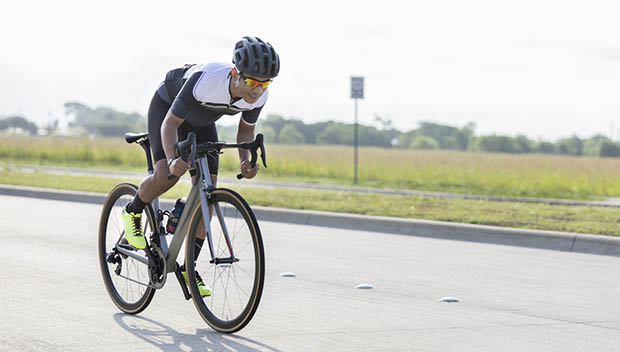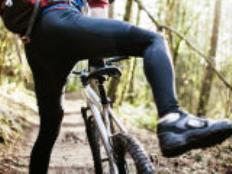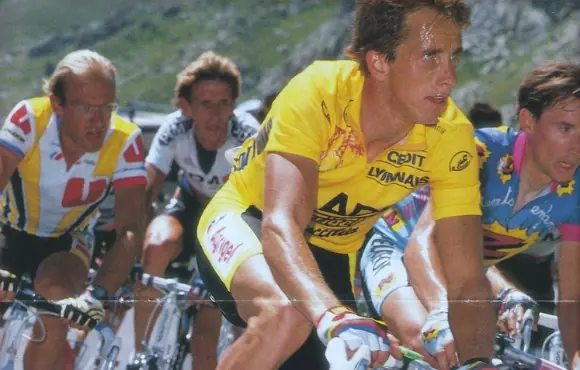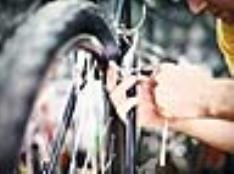
Whether you're new to cycling or have been riding indoors for a while and need a quick refresher, we have a few tips for staying safe, having fun and becoming an even better bike handler. Don't be afraid to try some of these skills on the grass at first--it won't hurt your tires, and should you topple, it's a softer landing than pavement.
Starting/Stopping (Clipping in/out)
Why It's A Crucial Skill: Starting and stopping at the beginning and the end of your ride, at traffic-controlled intersections or when making a short stop to top off a water bottle or grab a coffee, is a must-have skill. No one wants to topple over at a traffic light.
How to Practice: Clip your left foot in and let this foot come to rest just above horizontal. Get rolling by letting your body weight come down on this foot while giving a slight push with your right foot. You may need to take a few pedal strokes with one foot to get some speed and stability. Once you're moving, you can balance your weight on your left foot, hovering your bottom over the saddle, freeing your right leg so you can clip in with your right foot. When preparing to stop, drop your left foot to the bottom of the pedal stroke, and rotate your right heel outwards to release from your pedal. You can lightly rest your foot on your pedal as you decelerate. When you're about ready to stop, let your heel come down and then your cleat. Avoid dragging your foot, as it will prematurely wear your cycling shoes and cleats.
Pedaling
Why It's A Crucial Skill: Efficient pedaling is all about conserving effort.
How to Practice: When pedaling, don't stomp on the pedals. With comfortable cycling shoes and clipless pedals, you should be able to spin your way along; think of the motion of scraping mud off the ball of your foot. You can spin with the flexibility of a seasoned cyclist, just by thinking about being smooth, light and fluid--even when riding uphill or into a headwind.
Braking
Why It's A Crucial Skill: Knowing how and when to brake can save you effort and anxiety, as well as keep you safe.
How to Practice: On a straight, flat stretch of road, build up your speed. Slow yourself with your rear brake first, applying smooth, constant and even pressure. Add in the front brake, gradually squeezing ever so slightly to effectively modulate speed. When you're comfortable with this technique, repeat on a slight downhill.
Pro Tip: If you need to make an emergency or evasive stop, never grab your front brake lever; always use your rear brake first so you won't go over your bars. To slow quickly, apply confident, direct pressure to your rear brake, adding in your front brake with the same technique. Practice by using a marker on a flat stretch of road to indicate the location where you need to be stopped. With each practice attempt, try to slow more efficiently, starting your braking closer and closer to the stopping marker.
Shifting
Why It's A Crucial Skill: Shifting gears effectively will help you go faster with less effort--and less chance of mechanical malfunctions.
How to Practice: First, find a comfortable gear in front, and then adjust your gearing in back. When shifting, at the moment when the chain is moving to a different gear--in either direction--lighten up on your pedaling effort ever so slightly, just for half a crank revolution.
Pro Tip: Don't shift both the front and rear derailleurs simultaneously. Doing so can increase the likelihood of throwing your chain or missing a shift.
Climbing
Why It's A Crucial Skill: At some point, when the road pitches up, you'll need to get over it. How you get over it--the amount of effort--will directly affect how much reserves you'll have later on. You want to climb hard enough as to put distance and time into your competition, but not so hard that your legs are shattered.
How to Practice: Only get out of the saddle when you absolutely need to, as it uses a lot more energy for a marginal gain in speed. Sit up toward the back edge of your saddle. Keep your eyes toward the top of the hill. Relax, lightly gripping your bars or brake hoods. Spinning is always better than stamping and grinding the cranks. When you do need to stand, "dance" on the pedals and don't stomp, rocking the bike back and forth rhythmically.
Descending
Why It's A Crucial Skill: If you're relaxed on a descent, you can recover from the preceding climb more efficiently and put time and distance into your competition by being in an aerodynamic position while safely having more fun.
How to Practice: You want to feel like you're sitting heavy on your saddle. Look up the road to where you will be so you can anticipate road grade, obstacles and other cyclists. If you're on a road bike, keep your hands in the drops for optimal control; if comfortable, you can put them on the bar tops, next to the stem.
Cornering
Why It's A Crucial Skill: Even if you're racing on a straight, out-and-back course, you'll need to turn around at some point. How efficiently you can make a course correction can save you precious seconds and also ensure safety.
How to Practice: Even on roads crowded with other cyclists, you want to approach a turn from the far side of the lane of travel; if turning left, you want to start your turn on the right side of the road and vice versa. This is referred to as "outside-inside-outside." As you execute the turn, you want to be as close to the inside of the turn as possible, where the bend in the road is most sharp. As you exit the turn, you can move back out to the far side of the road. If you're sharing the road with others, make sure to spot them so you don't cut anyone off, especially when moving toward the inside of the turn. Don't be afraid to vocalize your intent--"passing on the left"--so there are no surprises.
Riding in the Wind
Why It's A Crucial Skill: Not blowing up in headwinds and staying safe in crosswinds are skills that every cyclist can use.
How to Practice: Practicing riding in the wind can't be replicated on non-windy days. When you are riding in strong head- or crosswinds, pick a gear that's slightly harder than you would normally select and keep a slightly lower cadence for stability. Keep a light hand on your bars or brake hoods. Keep your eyes up, looking toward the horizon while staying seated. When encountering gusts, don't fight against them, as you're likely to oversteer. If winds are strong, maintain control of your bike through influencing it with your bodyweight on your saddle.
Riding in a Group, Shoulder to Shoulder
Why It's A Crucial Skill: Even if you're not racing, riding with a group of cyclists shoulder to shoulder, makes for a safe, social ride. Two cyclists side-by-side are more easily seen by traffic approaching from the rear. And most locales permit two-up riding for this reason (but you'll want to check your local traffic laws to be certain).
How to Practice: This skill cannot be practiced alone. On a low-traffic, straight and flat stretch of road, ride next to a partner. Gradually decrease the distance between cyclists until you're nearly touching. It's OK to even practice bumping shoulders. Keep your eyes forward, using peripheral vision to gauge distance to others at your sides. The cyclist farthest to the right side of the road dictates the distance to the edge of the road. If this person moves left or right, cyclists should move in parallel with them.
Standing/Sitting on the Saddle
Why It's A Crucial Skill: Especially when in a group, maintaining control of your bike is crucial for everyone's safety. You don't want your bike to drift backward as you change position.
How to Practice: As you are about to stand or sit in your bike saddle, let your bike move forward from underneath you as you downstroke with your dominant foot. This motion should propel your bike forward. Never stop pedaling as you change position on your saddle, as you're likely to drift backward.
READ THIS NEXT: 5 Common Bike-Handling Mistakes








Discuss This Article